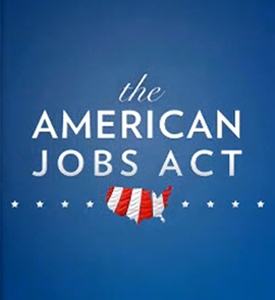President Obama continues to call upon Congress to pass the American Jobs Act. He has explained how his proposals will benefit the unemployed and put money back in Americans' pockets. One proposal includes Pathways Back to Work for Americans Looking for Jobs. This section of the president’s plan would help out-of-work Americans and their families by extending unemployment insurance to prevent six million Americans looking for work from losing their benefits, while at the same time reforming the system to help support programs that build real skills, connect to real jobs, and help the long-term unemployed. The president’s plan is targeted to address long-term unemployment in an aggressive, multi-pronged way, drawing from ideas about what is working from around the country and from both parties.
Key elements of his proposal are:
- The most innovative reform to the unemployment insurance program in 40 years: As part of an extension of unemployment insurance to prevent five million Americans looking for work from losing their benefits, the president’s plan includes innovative work-based reforms to prevent layoffs and give states greater flexibility to use Unemployment Insurance (UI) funds to best support job-seekers and connect them to work.
- A $4,000 tax credit to employers for hiring long-term unemployed workers.
- Prohibiting employers from discriminating against unemployed workers when hiring.
- Expanding job opportunities for low-income youth and adults by investing in promising and proven strategies and programs like summer jobs and sector-based training programs.
The most innovative reform to the unemployment insurance program in 40 years
Drawing on the best ideas of both parties and the most innovative states, the president’s plan will equip the UI system to better address our current long-term unemployment challenge. In these times, the federal emergency unemployment system must offer not just a weekly check, but also an aggressive strategy to connect the unemployed to work–through reforms ranging from rigorous assessment and job-search assistance to flexible work-based uses of federal UI to smart strategies to prevent layoffs in the first place. There will be rigorous reemployment assistance, work sharing: UI reform to prevent layoffs, and state flexibility for bold reforms to put the long-term unemployed back to work.
A $4,000 tax credit to employers
The president’s plan includes a tax credit for employers and companies who hire long-term unemployed applicants. Providing incentives to hire these out-of-work individuals ensures that we do not waste the skills and ambitions of those bearing the brunt of the painful recovery from recession.
On top of cutting payroll taxes in half for all American businesses, and a full payroll tax holiday for hiring or raising wages up to $50 million of payroll, this credit will provide an additional $8 billion to the “bang-for-the-buck” of dollars employers spend to hire unemployed workers.
Prohibiting employers from discriminating against unemployed workers
Recent reports have highlighted companies that are increasingly expressing preferences for applicants who already have a job. Specifically, some companies are posting job listings that include language such as “unemployed candidates will not be considered” or “must be currently employed” or “must be employed within the last six months.” The exclusion of unemployed applicants is a troubling and arbitrary screen that is bad for the economy, bad for the unemployed and ultimately bad for firms trying to find the best candidates. The president’s plan calls for legislation that would make it unlawful to refuse to hire applicants solely because they are unemployed or to include in a job posting a provision that unemployed persons will not be considered.
Expanding job opportunities for low-income youth and adults
The president’s plan for jobs and growth offers a particularly aggressive strategy to expand employment opportunities for communities that have been particularly hard hit by the recession, and that may take longer to get back on their feet due to greater income losses and smaller savings than higher-income workers. In August 2011, African Americans had an unemployment rate of 16.7 percent and Hispanics had an unemployment rate of 11.3 percent. The numbers were even worse for youth: 45 percent of youth between the ages of 16 to 24 were employed last month, including only 33.8 percent of African American youth. In fact, only 21 out of every 100 teens in low-income families had a job this past summer. Building on highly successful Recovery Act programs that provided job opportunities for low-income adults and youths, the president’s Pathways Back to Work Fund will make it easier for workers to remain connected to the workforce and gain new skills for long-term employment.



Comments Closed
Due to increased spam, comments have been closed on this content. If you wish to comment about the content, we encourage you to email webmaster@doc.gov.